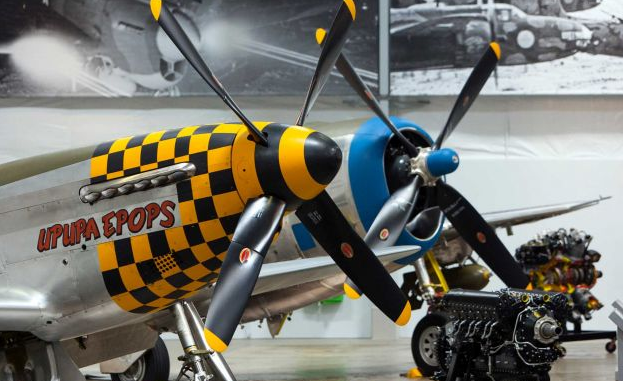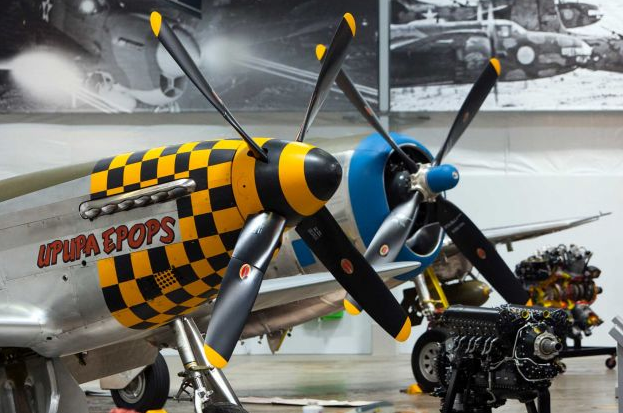

Today, April 12th the Flying Heritage Collection of Everett, Washington is opening a brand new 25,000 square foot addition to their already impressive 35,000 square foot facility. The brainchild of Microsoft co-founder Paul G. Allen, who began acquiring and preserving WWII-era planes and instruments of warfare in 1998. Allen’s passion for aviation and history and his awareness of the increasing rarity of original WWII aircraft motivated him to restore these artifacts to the highest standard of authenticity to share them with the public. More interestingly, the historic aircraft in the collection are not meant to simply be displayed in a static museum environment. As part of the Flying Heritage Collection, their destiny is to return to the skies where they belong. The museum hosts several “Free Fly Days” during the summer when various planes from the Collection are flown to keep them operational and exercised.
The thematic tie for the collection being put on display in the new hangar is the effect that the specific conditions present in each theatre of operation such as environment, weather or adversary’s strategy resulted in designs suited to those widely divergent conditions being brought forth. The original museum building’s 35,000 square feet of exhibit space focuses on the rapid development of military technology ushered in by World War II which unleashed one of the greatest leaps in technological advancement the world has ever seen. The new hangar showcases how the new technology was customized and in some cases purpose-built for the unique conditions of the various fronts in this truly world-wide war. From the urban and pastural environments of Western Europe, the snow and muck of Eastern Europe and Russia, the sand of North Africa, the jungles of Southeast Asia or the open ocean of the Pacific, each environment posed it’s own unique challenges requiring a custom solution, creating it’s own wave of ingenuity that compounded and magnified the technological advances as each player scrambled for the slightest edge that might gain them supremacy.
The war in the Pacific was initially at least an oceanic war, resulting in the Grumman F6F Hellcat, specifically designed with fold-up wings to allow for maximum loading of aircraft within the relatively tight confines of an aircraft carrier and painted with dark blue on top with nearly white blue paint on the bottom which helped the plane disappear when viewed against the predominant background color. Viewed from above the dark blue matched the sea and from below the white-blue blended with the sky and glare. Japan’s Mitsubishi A6M Zero fighters on the other hand had to be modified after the Japanese lost their carriers, adopting camouflage paint schemes for their new land-based fields allowing them to hide from Allied air raids in the jungles and forests.
War and physics are harsh mistresses and sometimes coldblooded decisions must be made. The Ilyushin Il-2, often referred to as “The Flying Tank” was built to slug it out, flying close to the ground in support of the Soviet Army. The plane was heavily armored with up to 1/2 an inch of steel surrounding the pilot’s seat and engines which allowed the plane to take an unprecedented number of hits and continue flying. The machine-gunner, located directly aft of the pilot was not so fortunate, being situated in a completely unprotected section of the fuselage, and the casualty rate for those men was extreme even by Soviet standards. Unfortunately, the planes could not take on more weight, particularly in the gunner’s position which upset the balance of the plane, and after trying to run the planes without the rear gunners, too many were lost to attacks from the rear. Gunners were much more expendable than planes and pilots, so the gunners were again placed in their exposed positions to sacrifice themselves for plane, pilot and country.
The Germans, already facing the end of the war for the Third Reich, improvised by mounting new guns to old Czech tanks creating the Jagdpanzer 38 which was a quick, cheap, improvised “tank killer” that could hide out in a building, jump out, fire and run away. Also newly on display is a Soviet Mikoyan MiG-29, M4 Sherman Tank and a Soviet T-34 tank.
In celebration of the grand opening of Hangar 2, admission will be free all day.

Be the first to comment
Graphic Design, Branding and Aviation Art